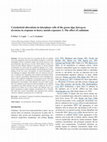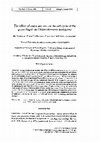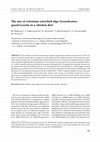Papers by Vilem Zachleder

Folia Microbiol Prague, Feb 1, 2002
Routinely prepared gametes (by flooding 3 week-old agar cultures) showed about 80 % mating compet... more Routinely prepared gametes (by flooding 3 week-old agar cultures) showed about 80 % mating competence if the opposite sexual partners were mixed together. The mating competence exhibited a strict dependence on the composition of the solution in which the cells were suspended before mixing; it decreased progressively with increasing concentration of nitrates. In contrast, no inhibiting effect was found ifurea was used as the source ofnitrogen. Other ions present in nutrient media did not show any effect. Mating activity varied according to the spectral composition of light, being higher with a blue light than with a red one. Blue light caused accumulation of vis-o-vis pairs, which were blocked to form zygotes. Freshly released daughter cells in vegetatively grown synchronous cultures had a dual naturevegetative and sexual one. In these daughter cells, similar rules were found for goveming of mating competence to those valid for standard gametes obtained from flooded agar cultures. High mating competence was found in daughter cells released the during dark period in distilled water, nitrate-free media, in the presence ofMg2+ or Ca2+ ions, or in media containing urea. The conditions during which daughter cells are released and the conditions under which they mate can be considered crucial for expression of gametic nature as a mating competence.

Photosynthesis Research, 2016
Lanthanides (La, Gd, Nd, Ce) accumulated in the green alga Desmodesmus quadricauda but their intr... more Lanthanides (La, Gd, Nd, Ce) accumulated in the green alga Desmodesmus quadricauda but their intracellular localizations were distinctly different: lanthanum and gadolinium were localized in cytoplasm, while neodymium and cerium were in the chloroplast. The effect of lanthanum and neodymium, as representatives of these two groups, on growth, chlorophyll content and photosynthetic rate at different light intensities was studied. At the lowest light intensity used (50 µmol photons m(-2) s(-1)), in the presence of lanthanides (Nd), growth was enhanced by as much as 36 % over lanthanide free control, and the photosynthetic rate increased by up to 300 %. At high light intensities (238, 460, and 750 µmol photons m(-2) s(-1)), photosynthetic rate increased markedly, but there was no significant difference between rates in the presence or absence of lanthanides. However, growth, measured as a percentage of dry weight, if compared with lanthanide free control, increased at all light intensities (31, 39, and 20 %, respectively). The total amount of chlorophyll after lanthanide treatment increased by up to 21 % relative to the control culture, mainly due to an increase in the level of chlorophyll b. Addition of lanthanides caused a change in the chlorophyll a/b ratio from 4.583 in control cultivation, to 1.05. Possible mechanisms of lanthanide-induced photosynthetic change, alterations in photosynthetic structures, and increases in growth are discussed and compared with findings in higher plants. The hypothesis that the lanthanide effect could be due to formation of lanthanide-pheophytins was not confirmed as lanthanide pheophytins were not found in D. quadricauda. Furthermore, we have shown that the preferential incorporation of heavy isotopes of magnesium, namely (25)Mg and (26)Mg, into chlorophyll during photosynthesis that occurred in controls was diminished in the presence of lanthanides.

Biotechnology for Biofuels, 2016
Algae have attracted attention as sustainable producers of lipid-containing biomass for food, ani... more Algae have attracted attention as sustainable producers of lipid-containing biomass for food, animal feed, and for biofuels. Parachlorella kessleri, a unicellular green alga belonging to the class Trebouxiophyceae, achieves very high biomass, lipid, and starch productivity levels. However, further biotechnological exploitation has been hampered by a lack of genomic information. Here, we sequenced the whole genome and transcriptome, and analyzed the behavior of P. kessleri NIES-2152 under lipid production-inducing conditions. The assembly includes 13,057 protein-coding genes in a 62.5-Mbp nuclear genome. Under conditions of sulfur deprivation, lipid accumulation was correlated with the transcriptomic induction of enzymes involved in sulfur metabolism, triacylglycerol (TAG) synthesis, autophagy, and remodeling of light-harvesting complexes. Three-dimensional transmission electron microscopy (3D-TEM) revealed extensive alterations in cellular anatomy accompanying lipid hyperaccumulation. The present 3D-TEM results, together with transcriptomic data support the finding that upregulation of TAG synthesis and autophagy are potential key mediators of the hyperaccumulation of lipids under conditions of nutrient stress.

Toxicology in Vitro, Aug 31, 2008
The aim of the study was to elucidate the effect of cadmium ions on the arrangement of the actin ... more The aim of the study was to elucidate the effect of cadmium ions on the arrangement of the actin and tubulin cytoskeleton, as well as the relationships between cytoskeletal changes and growth processes in the green filamentous alga Spirogyra decimina. Batch cultures of algae were carried out under defined conditions in the presence of various cadmium concentrations. In control cells, the cytoskeleton appeared to be a transversely oriented pattern of both microtubules and actin filaments of various thickness in the cell cortex; colocalization of cortical microtubules and actin filaments was apparent. Microtubules were very sensitive to the presence of cadmium ions. Depending on the cadmium concentration and the time of exposure, microtubules disintegrated into short rod-shaped fragments or they completely disappeared. A steep increase in cell width and a decrease in growth rate accompanied (and probably ensued) a very rapid disintegration of microtubules. Actin filaments were more stable because they were disturbed several hours later than microtubules at any cadmium concentration used. When cadmium ions were washed out, the actin cytoskeleton was rebuilt even in cells in which actin filaments were completely disintegrated at higher cadmium concentrations (40 or 100 M). The much more sensitive microtubules were regenerated after treatment with lower cadmium concentrations (10 or 15 M) only.
Plant and Cell Physiology, Mar 1, 1997

Using synchronous cultures, the effect of different concentrations of cadmium ions on the growth ... more Using synchronous cultures, the effect of different concentrations of cadmium ions on the growth and reproductive processes, both in the nucleocytoplasmic and chloroplast compartrnent of the cells of the tlagellate Chlamydomonas noctigama was studied. A loss of motility of cells was the first striking effect of cadmium. The concentrations of metalless than 20 !.lM had insignificant effect on the growth whereas at concentrations higher than 100 !.lM cell growth was completely blocked. With increasing concentration of cadmium ions, the number of commitment points in the cel I cycle decreased and distance between them prolonged. The growth ofthe cells was slowed down and the cel I cycle prolonged proportionally to the concentration of cadmium ions except of 5 !.lM which shorten the cell cycle. With exception of cytokinesis, the course of reproductive processes was not affected in the presence of cadmium ions. The formation of daughter cells at higher ion concentrations was irregular or blocked. In the chloroplast compartrnent, presence of cadmium ions caused destruction of chloroplasts and DNA-containing structures (nucleoids).
The technique devised by for fluorochroming nuclei in fission yeast was modified to give good res... more The technique devised by for fluorochroming nuclei in fission yeast was modified to give good results with chlorococcal algae. The preparations obtained are particularly suitable for counting of nuclei required to assess the coursc of nuclear divisions in cell cycles of chlorococcal algae.
Progress in clinical and biological research
In some species of chlorococca! algae (e.g. Scenedesmus and Chlorella) DNA structures failed to s... more In some species of chlorococca! algae (e.g. Scenedesmus and Chlorella) DNA structures failed to stain with 4',6-diamidino-2-phenylindole . 2 HCl when the procedures described in recent publications were applied. The qua1ity of staining worsened with the age of the cells and varied markedly a!so in cells grown under different growth conditions. Various treatments were examined to make these a!ga! cells stainable with the fluorescent dye. Freezing of the cells at -20°C followed by incubation in SDS solution (10 min in 2% SDS in disti1led water at room temperature) was found to be a sufficient pretreatment for reproducible sharp staining of structures containing DNA. The method was successfully applied to the cells of different developmental stages in a wide range of growth conditions in various taxa of green and blue-green a!gae.

The extent of benzo(a)pyrene (BP) inhibitory effects on macromolecular syntheses and cell-cycle c... more The extent of benzo(a)pyrene (BP) inhibitory effects on macromolecular syntheses and cell-cycle characteristics was studied in synchronous populations of the chlorococcal alga Scenedesmus quadricauda grown under various light conditions. The inhibitory effects of BP decreases with increasing density of the cen culture and with a decrease in the incident Írradiance of cultures; the inhibition was completely prevented by darkening of the cens. Mean irradiance per cen was decisive for the extent of BP inhibitory effects irrespective of the combination of incident Írradiance and culture density. A certain time period of algal cen growth in light was required for BP to become inhibitory active. The extent of inhibitory effects, therefore, tended to increase with the time of BP presence during the light period. BP added to the algal suspension was adsorbed quantitatively and rapidly by the cen surface and the extent of BP effects was related, under the given mean Írradiance and the length of light interval, tó the BP concentration per cen rather than to BP concentration per volume of nutrient medium.

Czech Journal of Animal Science
The selenium-enriched Scenedesmus biomass of patented selenium-resistant strain SeIV was tested i... more The selenium-enriched Scenedesmus biomass of patented selenium-resistant strain SeIV was tested in a broiler chicken diet in comparison with sodium selenite supplementation. Feed conversion, mortality and live weight were not significantly influenced by the source of selenium. Supplementation of either form of selenium significantly increased the Se concentration in breast muscle with a more pronounced effect (P < 0.001) caused by selenium enriched Scenedesmus (635 μg/kg DM, 229 μg/kg DM in control). Breast meat of chickens fed a diet with sodium selenite or Se-Scenedesmus had a significantly (P < 0.001) higher value of glutathione peroxidase activity (0.329 μmol/g, 0.361 μmol/g) compared to the basal diet (0.190 μmol/g). The inclusion of Se-Scenedesmus biomass in the diet enhanced (P = 0.021) oxidative stability of meat expressed as reduced malondialdehyde in breast meat after 10-day cooler storage. Se-enriched Scenedesmus can be a good source of organic selenium for the prod...

We developed an alternative method of staining cell nuclei and chloroplast nucleoids of algal cel... more We developed an alternative method of staining cell nuclei and chloroplast nucleoids of algal cells using SYBR Green I (the fluorescent dye used commonly for detecting dsDNA in agarose and polyacrylamide gels as an alternative to highly mutagenic ethidium bromide and for DNA staining of viruses and bacteria followed by flow cytometry, digital image analysis or real-time PCR), which enabled routine staining in vivo. Cells do not need to be fixed or treated chemically or physically before staining, thus the shape, size and position of DNA-containing structures are not affected. The fluorescence signal is sharp and reproducible. Examples of application of the method are shown in color microphotographs for representatives of eukaryotic algae from the taxa Chlorophyta, Rhodophyta and the prokaryotic Cyanophyta. The method is also useful for studying progress of the cell cycle in algal cells dividing by multiple fission, as shown by observation of changes in nuclear number during the cell cycle of the green alga Chlamydomonas reinhardtii and Scenedesmus quadricauda. Staining with SYBR Green I can be recommended as a fast, safe and efficient method for the detection of DNA-containing structures in vivo.

Uploads
Papers by Vilem Zachleder